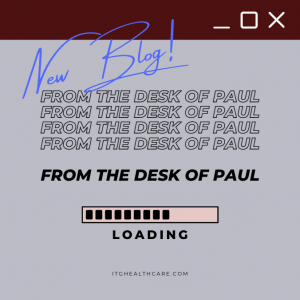From the Desk of Paul:
One of the characteristics that I love about private healthcare is that, for those physicians who own their practice, if they have good business sense, then they can provide the best healthcare available – and most of them do! It is important for all of us to recognize that in private healthcare, if there is no business, then there can be no healthcare! The situation described above, from a business perspective, means less revenue (patients not seeing their doctor as often as they should), and more expense (PPE and additional human resource requirements). Obviously, when we apply those changes to the generally accepted accounting practices equation for Net Income (Profit), we get an undesirable result: Revenue – Expenses = Net Income. Ultimately, for the reasons stated above and other pandemic-related reasons, there has been a negative impact on Net Income. If there is less or no Net Income, then there is no money for growth or even sustainability. Furthermore, cashflow may also be negatively impacted. With the high number of businesses failing, which increases unemployment and other businesses slashing benefits to try to survive, patients just don’t have the same ability to pay in a timely manner that they had just a year ago.
So, how can physician-owned medical practices circumvent some of these ill-effects. There are two strategies that I would suggest considering to minimize the negative impact and perhaps even allow us to create a healthier habit of managing the financial side of the medical practice:
- Consider shifting from Capital Expenditures (CapEx) to Operating Expenditures (OpEx). Every medical practice must spend money on equipment additions and upgrades to keep the practice going. Sometimes these expenditures are planned and sometimes they are not. Either way, these expenses are typically one-time costs that can be relatively high. For example, a digital X-Ray solution might cost tens or even hundreds of thousands of dollars; but many practices need that equipment to provide adequate healthcare. By financing the equipment, the high cost can be moved to OpEx, with a much smaller monthly payment over time. Ok, so everyone knows that, but did you know you can do the same with all of your technology equipment? With the right solution provider, everything from your security and surveillance system to your server hardware and software can be moved from CapEx to OpEx. If the interest on doing that is minimal enough, it could absolutely ease the financial pressure when Net Income and Cash Flow are not good, but there are equipment needs that cannot be neglected.
- The second strategy I would suggest exploring is a progressive financial model that is designed to prioritize the income of the practice differently. Some physician owners are implementing financial models that operate on the premise that as revenue comes in, a portion should be set aside for Net Income, a portion should be set aside for taxes, as well as compensation. What is left should be used for Operating Expenses. Obviously, I am over-simplifying the model for brevity, but essentially, this model teaches to take care of the higher priorities first. Without profit, the practice will not survive. Taxes and employees must also be paid, or the practice will not survive. Then there is everything else – all of the other expenses. Some of these can be reduced or eliminated and some cannot, but the model will help identify where the financial bleeding is occurring so the finances can be adjusted.
These two suggestions are just two more things to explore in an already busy time, but do not let that circumvent your efforts to improve. With the right partner, you can delegate a great deal of the heavy lifting for both of these strategies. I would love the opportunity to discuss it with you – stop what you are doing right now and call or email me!
Paul Meadows,
President/CEO







